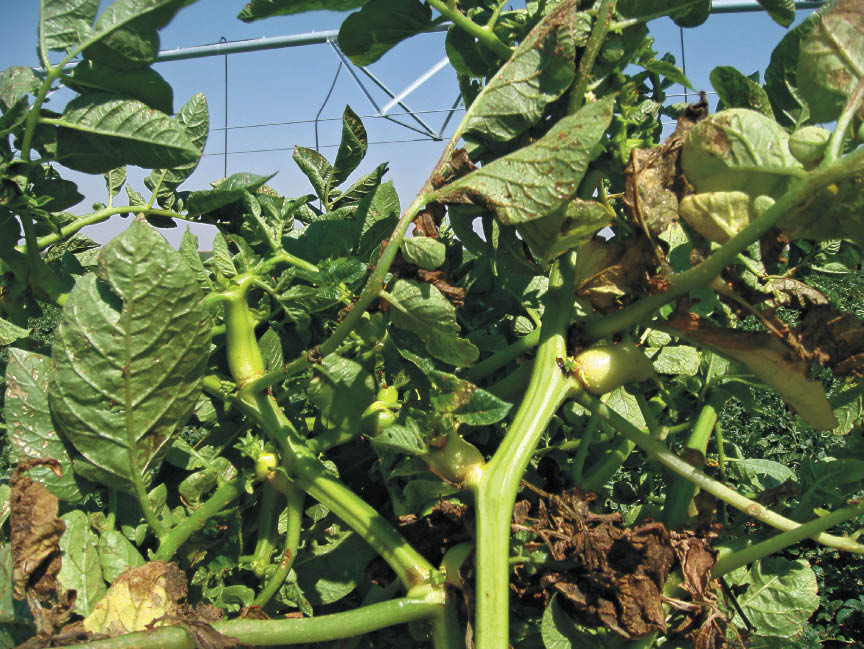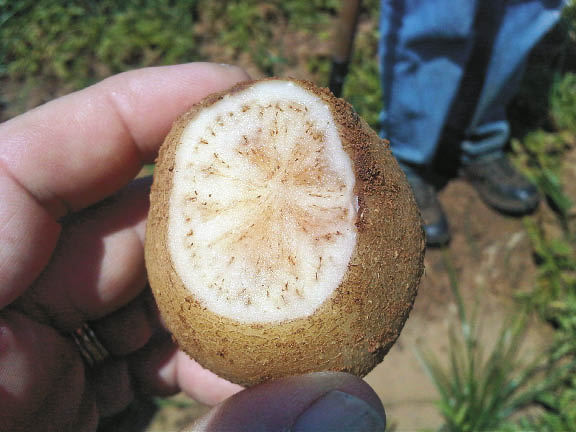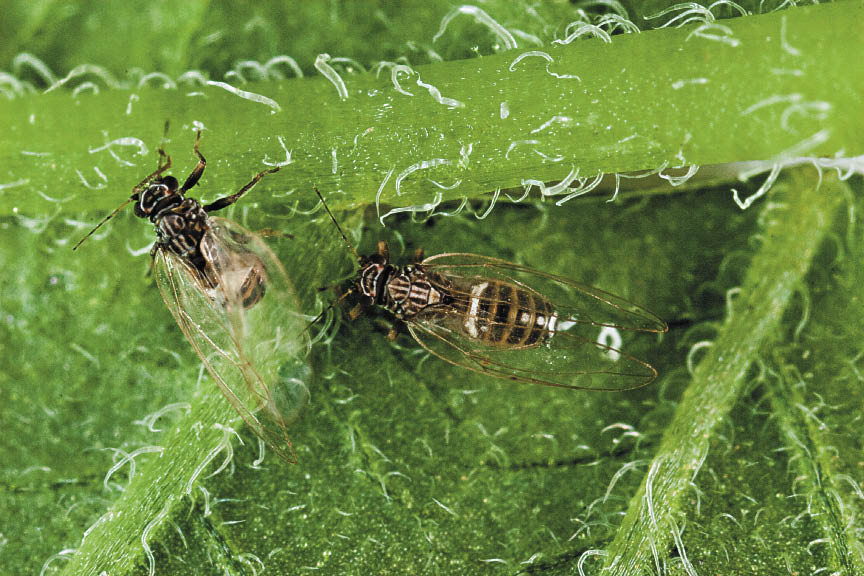 It seems as though a southern threat is moving north.
It seems as though a southern threat is moving north.
The culprit? Potato psyllids-tiny, cicada-like insects related to aphids that are normally found in warmer regions such as Texas and Mexico rather than the Pacific Northwest. With them, they bring bacteria-like organisms that carry a potato disease known as zebra chip. While zebra chip, named for the dark bands that develop in infected potatoes, isn't associated with any known health safety or nutritional problem, it's a threat to tuber quality for growers and processors-particularly affecting processed french fries and potato chips by creating darker chips and fries. The dark coloration results from changes in stored sugars that caramelize when the potatoes are processed.
Zebra chip was first detected in Mexico in 1994. By the end of the decade, it was found in Texas, and by 2007 it had spread to California, Colorado, Kansas and Nebraska, according to Phil Nolte, University of Idaho Extension seed potato specialist.
The first week of October, zebra chip was found in Idaho, as confirmed by UI Extension specialists with the College of Agricultural and Life Sciences. Just the month before, it was reported in Oregon and Washington.
Growers in LaSalle, Colo., have heard this tune before, just last year-they experienced an unprecedented infestation of psyllids in 2010-thankfully without the zebra chip pathoge. This year, however, there have been very few psyllids found in area potato fields.
So, what did Colorado growers do to reduce the numbers?
 Texas Rangers
Texas Rangers
Zebra chip was confirmed in Idaho by USDA Agricultural Research Service tests of samples from a potato processor and tracked to a field in Jerome County. Several confirmed reports also recently were made in Twin Falls County. While psyllids were found in several fields, the number of infected plants appeared low.
Sampling at the Kimberly Research and Extension Center showed the insects had infected several varieties, according to UI Extension potato specialist and storage researcher Nora Olsen.
"The question is whether this is an artifact of the unusual weather we had earlier this year or whether this is going to be a long-term problem," Olsen said.
Dr. John A. Goolsby, research entomologist for the USDA-ARS in Weslaco, Texas, says the psyllid has been a problem in Texas off and on for many years.
"What's changed is now it's associated with a disease it did not have before. We don't know the origin of the disease, but the bacteria, when it combines with the potato psyllid can produce the zebra chip disease in potatoes."
Since the problem started developing in Texas in 2000, much like Texas Rangers they've been tracking the problem.
"We track the potato psyllid as it moves north over winters down here in the Rio Grande Valley in south Texas. As spring comes, it gradually moves north, following the potato planting sequence. It comes back again to the Rio Grande Valley over winter. So we track that year-round life cycle and determine how many of the psyllids are infected with the disease and help growers determine how bad it's going to be in their area."
Harry Strohauer, a fresh market grower of russets, Yukons and fingerlings in LaSalle, Colo., said that psyllids had a "devastating" effect in 2010-hitting some of the russets the hardest-reducing their yields by 90 percent in some cases.
"We had potatoes that certainly weren't worth digging that we went ahead and dug just because we have commitments of the supply," he says.
Speaking of digging, the bugs made the vines much more difficult to kill.
"We were spraying, chopping, burning," he says. "We just couldn't get the vines to die. Not only is that a cost, but then you have the complication [that] they don't release the potatoes off the vine, so you have them going out the back end of the harvester, which was a huge problem for our fingerlings. If it was just the yield, that's one thing."
According to Goolsby, psyllids heavily impacted northeastern Colorado and southwestern Nebraska.
"They weren't associated with the zebra chip disease, but there were so many psyllids up there that by themselves the psyllids would be damaging without the disease when they reach [those] high numbers."
By themselves, the bugs cause what's called "psyllid yellows"-scorched, yellow-looking leaves-and a dramatic drop in yield.
"It's primarily a yield decline, not a quality decline like you get with zebra chip," Goolsby says
 Best Management Practices
Best Management Practices
For 2011, growers in northeastern Colorado and Nebraska implemented strong, preventative best management practices to curtail another infestation, focusing on early-season control.
Those BMPs included wise insecticide choices early on, with pre-plant insecticides and early-season applications of foliar insecticides in order to prevent early-arriving psyllids from starting in the fields.
All of the potato-growing areas in Nebraska, Kansas, Texas and northeastern Colorado worked with extension services this year by collecting leaves and traps, and then sending the data down to Goolsby in Weslaco, Texas. He would evaluate the numbers and then send out a weekly report to the growers.
This year, psyllids returned but not nearly in the same numbers as last year, and the growers were better informed. Strohauer says the weekly USDA reports were helpful, thanks to the cooperation of growers who participated.
"The cooperation of growers in Colorado, Nebraska and Kansas in doing these samplings and sharing the results was huge for us," he says.
While Goolsby points out that the excessive hot weather last summer could've had something to do with the low disease pressure, he says they truly don't know what made the difference in the psyllid population.
"Certainly the best management practices prevented anything from getting started in that area," he says. "That's the key-control the psyllid very early when it's at very low density so you don't let a problem develop in your field."
Strohauer points out that they've had psyllids around for the 35 years he's been growing potatoes, but it's been nothing like the infestation they had in 2010.
"Now that we know it's possible for them to be that severe, we'll never let our guard down," he says.
The costs to prevent another infestation will be systemic from here on out for Strohauer.
"It's not like you can wait until the psyllids show up and control them. If you do that, you're done. There is no controlling them once they're there," he says.